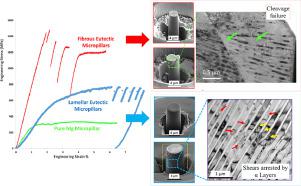Acta Materialia ( IF 8.3 ) Pub Date : 2021-01-05 , DOI: 10.1016/j.actamat.2021.116624 Soodabeh Azadehranjbar , Bingqiang Wei , Dongyue Xie , Kaisheng Ming , Jian Wang , Jeffrey E Shield

|
Owing to their low density and high strength-to-weight ratio, Mg alloys are attractive for automotive and aerospace applications. However, the current use of magnesium in the industry is limited due to the low strength and poor formability at ambient temperatures. Two-phase nanostructured materials are a promising solution to improve the mechanical properties of Mg alloys. Depending on processing parameters, either fibrous or lamellar morphologies can be formed via the eutectic transformation. In this work, the mechanical behavior of these two different morphologies were examined by in-situ SEM microcompression tests. The lamellar morphology exhibited a superior combination of strength and plasticity with respect to the fibrous morphology, and both showed superior strength relative to pure Mg, up to five-fold in the former and 12-fold in the latter. However, the higher strength in the fibrous eutectic was obtained at the expense of a low plasticity. According to the HR/TEM analyses of the deformed micropillars, the relatively high plasticity of the lamellar morphology was attributed to the two reasons; on the one hand, high dislocation activity was observed in both α and β phases and resulted in plastic co-deformation of the layers. On the other hand, the α layers played a significant role in restricting the shear instabilities that initiated in the β layers. Such an effect was not observed with the fibrous morphologies, and thus, they failed by cleavage along the closest-packed planes in the β crystal.
中文翻译:

层状与纤维状共晶Mg-Al纳米复合材料的强度和可塑性:原位微压缩研究
由于其低密度和高强度重量比,Mg合金在汽车和航空航天应用中具有吸引力。但是,由于在环境温度下强度低和可成形性差,因此目前在工业上使用镁受到限制。两相纳米结构材料是改善Mg合金力学性能的有前途的解决方案。根据工艺参数,可以通过共晶转变形成纤维状或层状形态。在这项工作中,这两种不同形态的机械行为通过原位SEM微压缩测试进行了检查。相对于纤维形态,层状形态表现出强度和可塑性的优良组合,并且相对于纯Mg,两者均表现出优良的强度,前者最多增加5倍,后者增加12倍。但是,以低可塑性为代价获得了较高的纤维共晶强度。根据变形微柱的HR / TEM分析,层状形态的较高可塑性归因于两个原因。一方面,在α和β相中都观察到了高位错活性,并导致了层的塑性共变形。另一方面,α层在限制起始于β层的剪切不稳定性方面起着重要作用。纤维形态没有观察到这种作用,因此,它们由于沿β晶体中最紧密堆积的平面的裂解而失败。根据变形微柱的HR / TEM分析,层状形态的较高可塑性归因于两个原因。一方面,在α和β相中都观察到了高位错活性,并导致了层的塑性共变形。另一方面,α层在限制起始于β层的剪切不稳定性方面起着重要作用。纤维形态没有观察到这种作用,因此,它们由于沿β晶体中最紧密堆积的平面的裂解而失败。根据变形微柱的HR / TEM分析,层状形态的较高可塑性归因于两个原因。一方面,在α和β相中都观察到了高位错活性,并导致了层的塑性共变形。另一方面,α层在限制起始于β层的剪切不稳定性方面起着重要作用。纤维形态没有观察到这种作用,因此,它们由于沿β晶体中最紧密堆积的平面的裂解而失败。α层在限制起始于β层的剪切不稳定性中起着重要作用。纤维形态没有观察到这种作用,因此,它们由于沿β晶体中最紧密堆积的平面的裂解而失败。α层在限制起始于β层的剪切不稳定性中起着重要作用。纤维形态没有观察到这种作用,因此,它们由于沿β晶体中最紧密堆积的平面的裂解而失败。











































 京公网安备 11010802027423号
京公网安备 11010802027423号